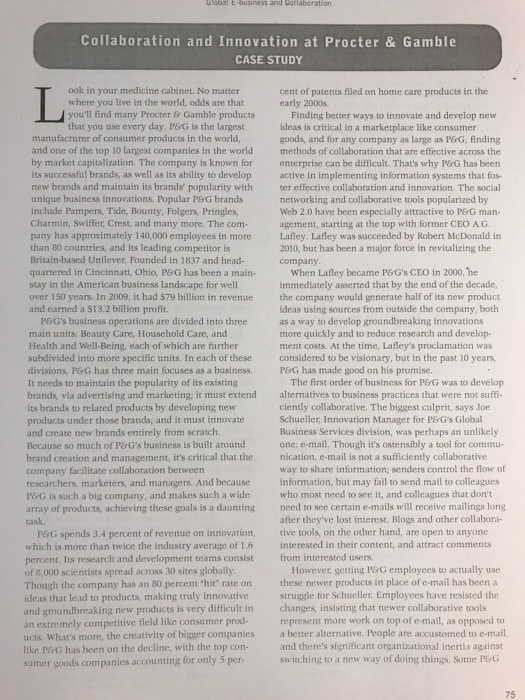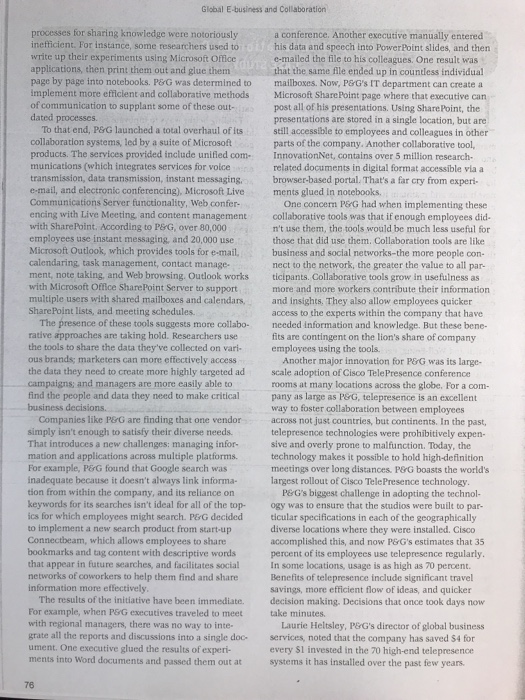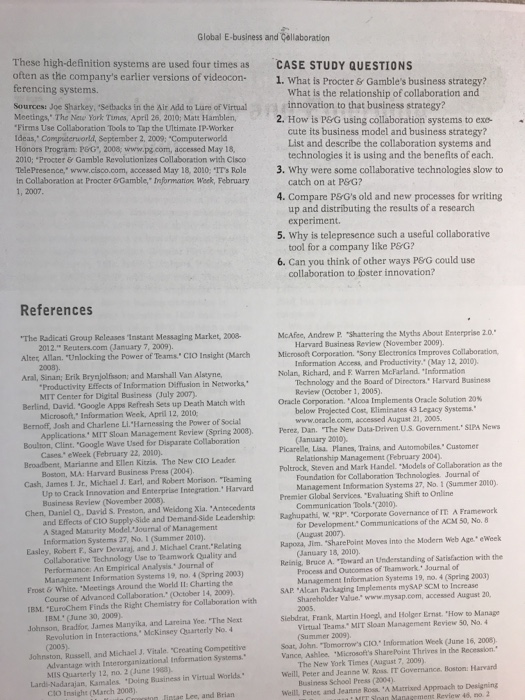Collaboration and Innovation at Procter & Gamble CASE STUDY ook in your medicine cabinet. No matter where you live in the world, odds are that you'll find many Procter&Gamble products that you use every day. P&G is the largest cent of patents filled on home care products in the Finding better ways to innovate and develop new ideas is critical in a marketplace like consumer goods, and for any company as large as P&G, finding methods of collaboration that are effective across the enterprise can be difficult. That's why P&G has been active in implementing information systems that fos- ter effective collaboration and innovation. The social networking and collaborative tools popularized by Web 2.0 have been especially attractive to P&G man- agement, starting at the top with former CEO A.G Lafley. Lafley was succeeded by Robert McDonald in 2010, but has been a major force in revitalizing the company manufacturer of consumer products in the world, and one of the top 10 largest companies in the world by market capitalization. The company is known for successful brands, as well as its ability to develop new brands and maintain its brands' popularity with business innovations. Popular P&G brands include Pampers, Tide, Bounty, Folgers, Pringles, Charmin, Swiffer, Crest, and many more. The com- pany has approximately 140,000 employees in more than 80 countries, and its leading competitor is in-based Unilever. Founded in 1837 and head- When Lafley became P&G's CEO in 2000, he immediately asserted that by the end of the decade the company would generate half of its new product ideas using sources from outside the company, both as a way to develop groundbreaking innovations more quickly and to reduce research and develop- ment costs. At the time, Lafley's proclamation w considered to be visionary, but in the past 10 years, P&G has made good on his promise. quartered in Cincinnati, Ohio, P&G has been a main- stay in the American business landscape for well over 150 years. In 2009, it had $79 billion in revenue and earned a $13.2 billion profit. P&G's business operations are divided into three main units: Beauty Care, Houschold Care, and Health and Well-Being, each of which are further subdivided into more specific units. In each of these ions, P&G has three main focuses as a business. The first order of business for P&G was to develop It needs to maintain the popularity of its existing brands, via advertising and marketing: it must extendalternatives to business practices that were not suffi- its brands to related products by developing new products under those brands; and it must innovate and create new brands entirely from scratch. Because so much of P&rG's business is built around brand creation and management, it's critical that the nicaion, e-mail is not a sufficiently collaborative ciently collaborative. The biggest culprit, says Joe Schueller, Innovation Manager for P&G's Global Business Services division, was perhaps an unlikely one: e-mail. Though it's ostensibly a tool for commu facilitate collaboration between way to share information; senders control the flow of researchers, marketers, and managers. And because information, but may fail to send mail to colleagues P&G is such a big company, and makes such a widewho most need to see it, and colleagues that don't array of products, achieving these goals is a daunting need to see certain e-mails will receive mailings long after they've lost interest. Blogs and other collabora P&G spends 3.4 percent of revenue on innovation, tive tools, on the other hand, are open to anyone which is more than twice the industry average of 1.6 percent. Its research and development teams consist of 8,000 scientists spread across 30 sites globally Though the company has an 80 percent 'hit" rate on ideas that lead to products, making truly innovative and groundbreaking new products is very difficult in an extremely competitive field like consumer prod represent more work on top of e-mail, as opposed to ucts. What's more, the creativity of bigger companies a better alternative. People are accustomed to e-mail like P&G has been on the decline, with the top con- sumer goods companies accounting for only 5 per- interested in their content, and attract comments from interested users. However, getting P&G employees to actually use these newer products in place of e-mail has been a struggle for Schueller. Employees have resisted the changes, insisting that newer collaborative tools and there's significant organizational inertia against switching to a new way of doing things. Some PEG 75









